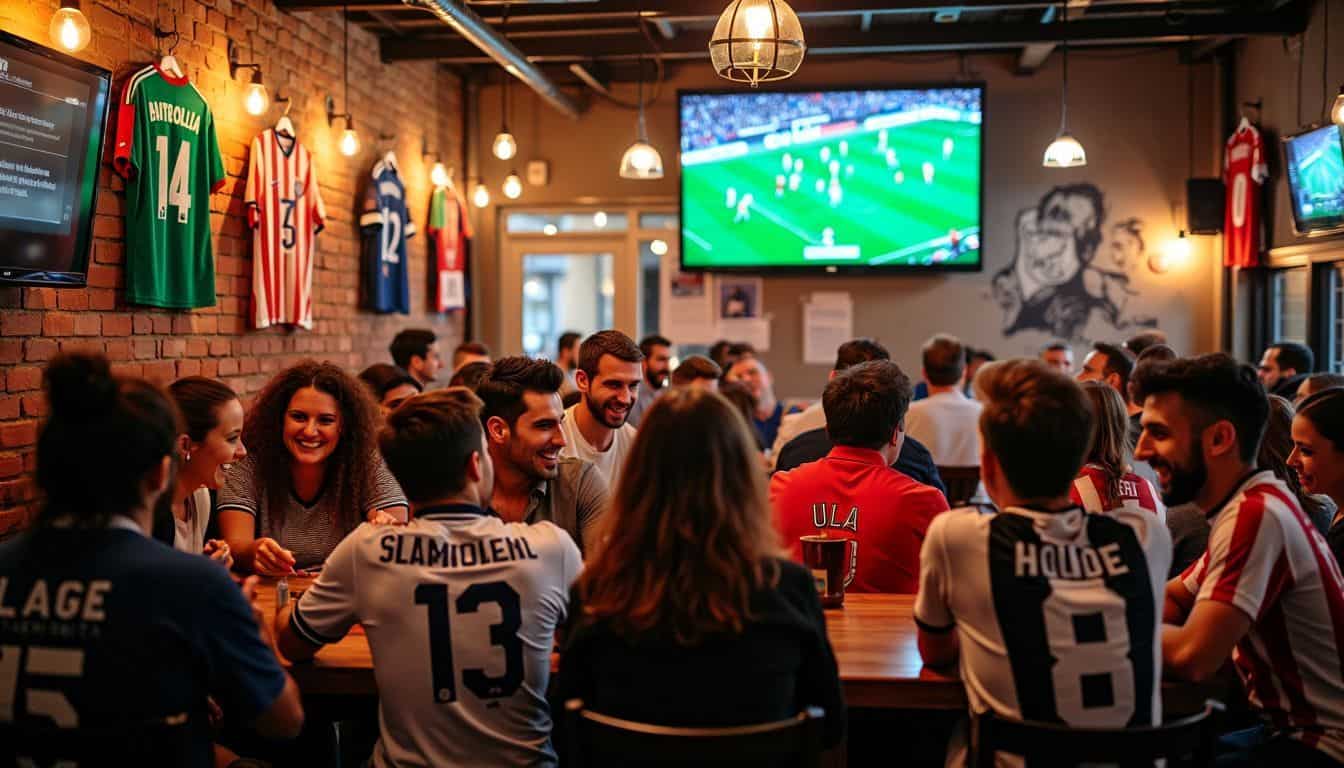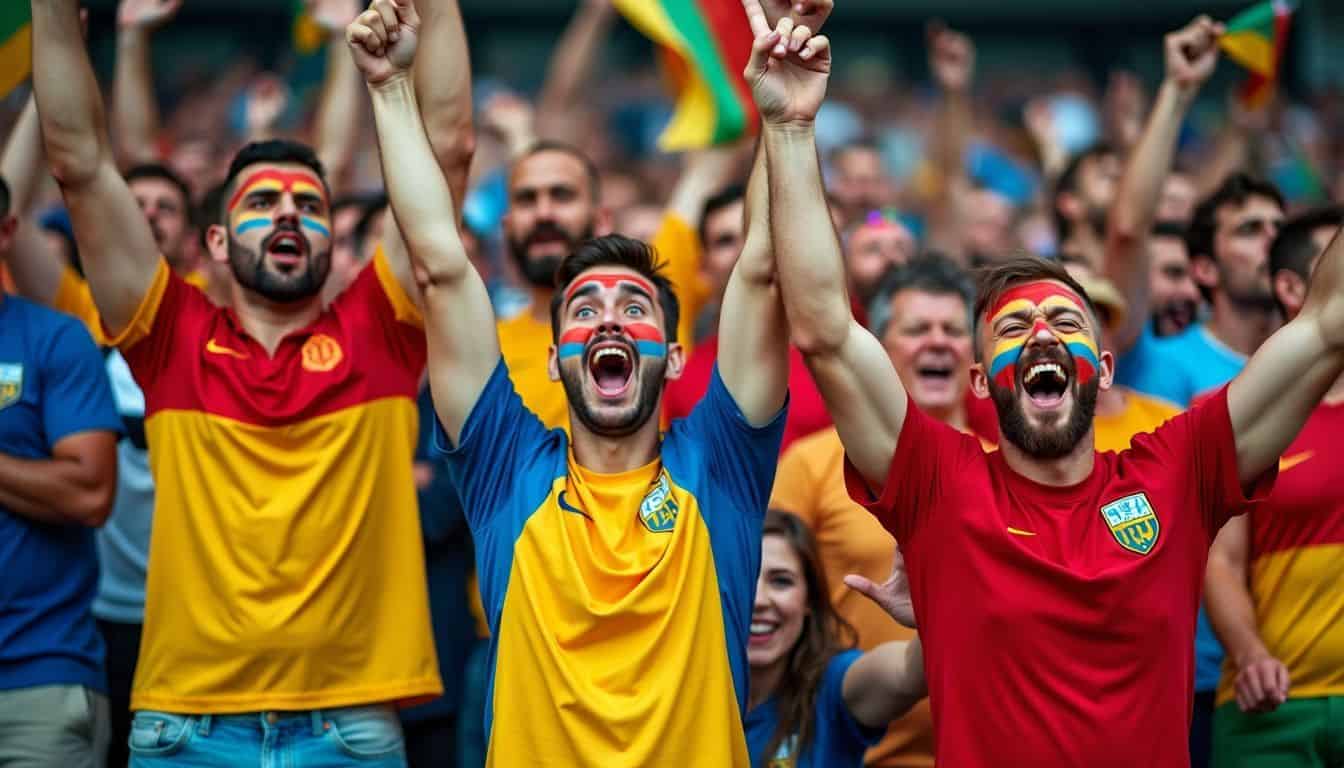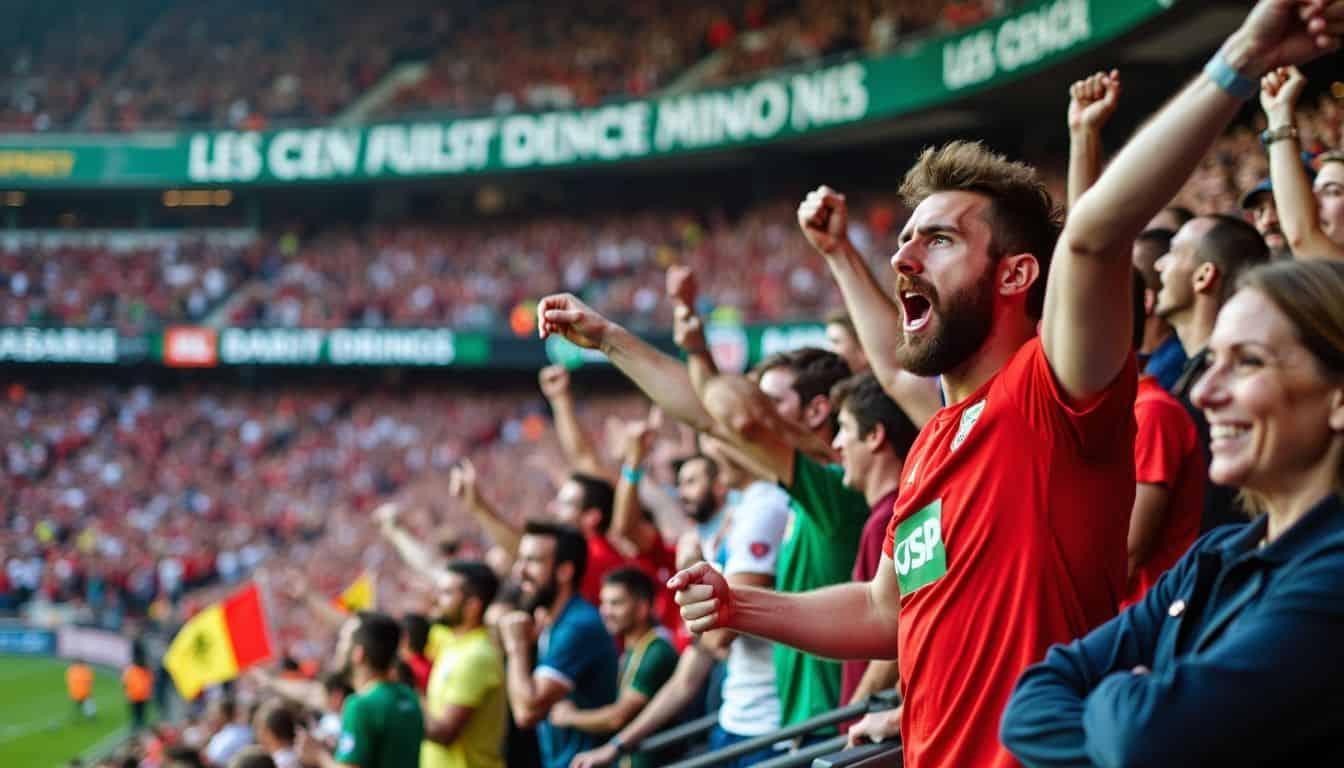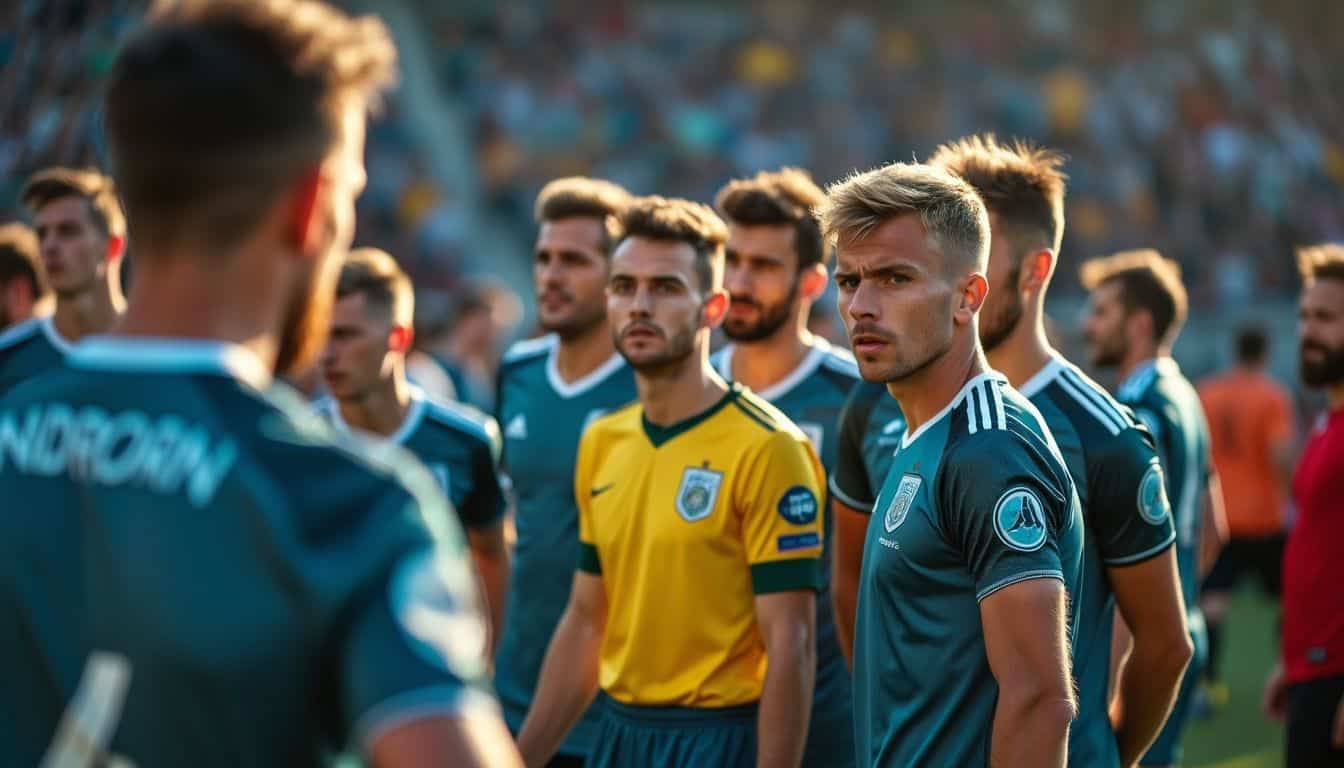Ever wondered about the buzz around European soccer? You’re not alone! Many folks are puzzled when they hear “Champions League” or “Premier League.” What’s European soccer, anyway? It’s the most popular sport globally, with over 4 billion fans worldwide.
This article will explain the basics and share some exciting facts about the beautiful game. Ready to kick off into European soccer?
Key Takeaways
European football, also called soccer, is played by two teams of 11 players each for 90 minutes, aiming to score goals by kicking a ball into the opponent’s net.
Major European leagues include the English Premier League, Spain’s La Liga, Italy’s Serie A, Germany’s Bundesliga, and France’s Ligue 1, each with unique playing styles and passionate fan bases.
The UEFA Champions League is the most prestigious club tournament in Europe, featuring top teams from 55 countries competing for glory.
Youth academies like Barcelona’s La Masia and Ajax Academy play a crucial role in developing young talent, often starting with children as young as 6 or 7 years old.
Video Assistant Referee (VAR) technology has been introduced to modern European football, aiming to make the game fairer but also sparking debates about its impact on the flow of matches.
Table of Contents
Understanding European Football

European football is more than just a game. It’s a passion that unites millions across the continent – and beyond!
Defining the Sport

European football, also known as soccer in some parts of the world, is a thrilling sport played with a round ball. Two teams of eleven players each try to score goals by kicking the ball into the opponent’s net.
The game lasts 90 minutes, split into two 45-minute halves. Players use their feet, heads, and bodies – but never their hands or arms – to control and move the ball.
This beautiful game has a rich history dating back over 100 years. It’s governed by UEFA in Europe, which runs big tournaments like the Champions League. The sport has a huge fan base, with matches drawing massive crowds.
Women’s football has grown a lot too, especially with events like the Women’s World Cup getting more attention.
Cultural Impact and Popularity

Moving from the basics, let’s kick off with the cultural impact of European football. It’s more than just a sport – it’s a way of life for millions. Fans live and breathe football, passing their passion down through generations.
This love affair shapes local traditions and creates fierce rivalries. Communities rally around their teams, turning match days into festive events. The sport’s reach extends far beyond the pitch, influencing art, music, and even politics.
European football’s popularity is off the charts. Major leagues like the Premier League and La Liga are global powerhouses. They showcase top-notch teams that draw fans from all corners of the world.
The UEFA Champions League takes it up a notch, featuring elite squads from 55 countries. It’s a true continental showdown that keeps viewers glued to their screens. Social media and platforms like FIFA TV help spread the football fever worldwide.
Fans can now catch highlights, interviews, and behind-the-scenes action with just a tap. It’s no wonder that European football has become a cultural phenomenon, uniting people across borders through their shared love of the beautiful game.
For those looking to add some extra excitement, odds via Boylesports can spice up the match-day experience.
Leading European Football Leagues

European football leagues are the heartbeat of the sport. They’re where the magic happens – from jaw-dropping goals to nail-biting finishes.
Spotlight on the English Premier League

The English Premier League (EPL) is a big deal in European football. It’s fast, exciting, and full of drama. Twenty teams battle it out each season, playing 38 games each. The league’s top clubs – like Manchester City, Liverpool, and Manchester United – are known worldwide.
They spend big bucks on star players and have fans all over the globe.
Money plays a huge role in the EPL. Teams can buy and sell players during set transfer windows. This is different from U.S. sports, where trades happen at specific deadlines. The EPL also has no salary cap, letting rich clubs splash cash on top talent.
But it’s not just about the big spenders. Smaller clubs can make money too. They often include “sell-on clauses” in contracts, getting a cut when their former players move to bigger teams.
Football is a simple game; 22 men chase a ball for 90 minutes and at the end, the Germans win. – Gary Lineker
Overview of La Liga (Spain)

La Liga is Spain’s top soccer league. It’s a big deal worldwide, with fans in every corner of the globe. This league has given us some of the best players ever. Think Lionel Messi and Cristiano Ronaldo – they both made their mark here.
La Liga isn’t just about stars, though. It’s got fierce rivalries, too. The biggest? “El Clásico” between Barcelona and Real Madrid. Talk about edge-of-your-seat stuff!
La Liga keeps things fresh with a promotion system. The bottom teams can drop out, while new ones move up from the Segunda División. It’s like a soccer version of musical chairs! This setup keeps the games exciting year after year.
Now, let’s check out another top European league – Serie A in Italy.
Insights into Serie A (Italy)

Serie A is Italy’s top football league. It’s a big deal in Europe, with famous teams like Juventus and Inter Milan. I’ve watched Serie A matches, and they’re full of passion! The games are fast-paced, with lots of goals and drama.
Italian fans are super loud and proud of their teams.
Money talks in Serie A. Winning the league means big bucks for clubs. Teams fight hard to grab that top spot. It’s not just about glory – it’s about cash too. Serie A has some of the world’s best players, like Cristiano Ronaldo when he played for Juventus.
The league’s mix of skill and tactics makes it a treat to watch.
Exploring Bundesliga (Germany)
The Bundesliga is Germany’s top football league. It’s a thrilling competition with 18 teams battling for glory each season. Fans pack the stadiums, creating an electric atmosphere that’s hard to beat.
The league is known for its fast-paced action and young talent. Teams play 34 matches, facing each other twice – once at home and once away.
Football is like life – it requires perseverance, self-denial, hard work, sacrifice, dedication and respect for authority. – Vince Lombardi
I’ve been lucky enough to catch a few Bundesliga games in person. The energy is incredible! You’ll see passionate supporters waving flags and singing team songs. The league also has a cool system where the bottom teams can drop to a lower division.
This keeps things exciting right to the end of the season.
Features of Ligue 1 (France)
Ligue 1, France’s top football league, packs a punch with its fast-paced action and rising stars. It’s home to big-name clubs like Paris Saint-Germain and Olympique Lyonnais. These teams often shine in the UEFA Champions League, showing off French football’s strength.
Ligue 1 is known for its young talent – many future superstars get their start here before moving to other top European leagues.
French football has a unique flavor. Teams in Ligue 1 focus on quick, attacking play. This makes for exciting matches that keep fans on the edge of their seats. The league also has a strong youth system, helping to grow local talent.
This mix of homegrown players and international stars makes Ligue 1 a thrilling watch for football lovers.
Prominent European Football Tournaments

European football tournaments are a big deal. They’re like the Super Bowl, but with more teams and way more excitement!
The Prestige of UEFA Champions League
The UEFA Champions League is the crème de la crème of European club soccer. It’s where the best teams from 55 countries duke it out for glory. Imagine the thrill of seeing Barcelona face off against Manchester United, or Real Madrid taking on Bayern Munich.
These matchups are pure magic! The Champions League isn’t just another trophy – it’s the holy grail of club soccer. Winning it can make a team’s entire season… heck, their entire decade!
The Champions League nights are special. – Pep Guardiola
Teams that don’t make the cut for the Champions League get a shot at the Europa League. It’s like a consolation prize, but still pretty sweet. The Champions League is where legends are born and dreams come true.
If you’re new to watching sports, this tournament is a great place to start. Next up, let’s chat about another exciting European soccer competition – the UEFA Europa League.
Excitement of UEFA Europa League
The UEFA Europa League is a thrill ride for football fans. It’s like a wild party where teams from all over Europe battle it out. Imagine underdogs taking on giants, last-minute goals, and nail-biting penalty shootouts.
It’s edge-of-your-seat stuff!
I’ve been lucky enough to attend a few Europa League matches. The atmosphere is electric – fans singing, flags waving, and the roar when a goal is scored… it’s unforgettable! This tournament gives smaller clubs a shot at glory.
It’s about winning, the journey, the drama, and the pure joy of the beautiful game.
Highlight on Domestic Cups (e.g., FA Cup, Copa del Rey)
Domestic cups in European football are a big deal. Take the FA Cup – it’s been around since 1871! That’s older than your great-grandma’s china. It’s like a football party where teams from all levels can join in.
Big clubs, small clubs… everyone’s invited. Spain’s got its own version too – the Copa del Rey. It kicked off in 1903 and is still going strong. These cups are super exciting because anyone can win.
It’s not just about the big boys showing off. The winners often get a ticket to play in Europe, which is pretty cool.
These tournaments are knockout style – lose once, and you’re out. It’s nail-biting stuff! Fans love it because their team might pull off a surprise win against a top club. It’s like David vs Goliath, but with cleats and a ball.
The magic of the cup, they call it. And boy, does it live up to the hype! You never know what’s gonna happen next. That’s what makes these domestic cups so thrilling.
The Economics of European Football

Money talks in European football – and it talks loud! From mega-rich owners to sky-high transfer fees, the sport’s economics are wild. Clubs splash cash like there’s no tomorrow, while TV deals and sponsorships rake in billions.
Analysis of Club Ownership and Finances
European football clubs have complex ownership structures and financial systems. Let’s dive into the money matters that keep these teams kicking!
- Club Ownership: Many teams are owned by wealthy individuals or groups. Some big clubs, like Real Madrid, are owned by their fans through a membership system.
- Financial Fair Play: UEFA rules aim to keep clubs from spending more than they earn. This helps prevent teams from going broke or getting an unfair edge.
- Revenue Sources: Clubs make money from ticket sales, TV deals, and merchandise. Big teams also cash in on global tours and sponsorships.
- Transfer Market: Buying and selling players is a huge part of club finances. Some teams focus on developing young talent to sell for profit later.
- Wage Bills: Player salaries are often the biggest expense for clubs. Top stars can earn millions per year, putting pressure on team budgets.
- Stadium Income: Owning a stadium can be a gold mine for clubs. They can host events and rent out spaces to boost their bottom line.
- Debt Management: Many clubs carry debt, but it’s how they handle it that counts. Smart borrowing can fund growth, while too much can spell trouble.
- Financial Reporting: Clubs must open their books to league officials. This transparency helps keep the sport fair and financially sound.
Now, let’s take a closer look at some of the biggest tournaments that light up the European football calendar.
Trends in Player Transfers and Contracts
Player transfers and contracts are a big deal in European football. They shape teams and spark excitement among fans. Here’s what you need to know:
- Big money moves: Clubs shell out huge sums to snag top talent. Some transfers can cost over $100 million!
- Release clauses: Many contracts have a set price for other teams to buy a player. It’s like a price tag on a star athlete.
- Transfer windows: Clubs can only buy or sell players during two specific times each year. It’s a bit like shopping seasons for football teams.
- Young talent hunt: Teams start scouting kids as young as 8 or 10 years old. There’s no draft system like in American sports.
- Sell-on clauses: Smaller clubs often add these to contracts. If their player gets sold again, they get a cut of the profit.
- Year-round deals: While transfers happen in windows, teams can sign contracts anytime. It keeps things buzzing all year.
- Women’s game growth: The Women’s World Cup has put a spotlight on female players. More fans are noticing their skills and strategies.
- Global marketplace: Players move between countries all the time. It’s a worldwide job market for footballers.
Next up, let’s dive into how European football is run and the rules that keep the game fair and exciting.
Overview of Sponsorship and Broadcasting Rights
Moving from player transfers, let’s talk money – the big bucks in European football. TV deals and sponsorships are huge! They’re like the fuel that keeps the soccer machine running.
Big companies love to slap their logos on jerseys and stadiums. It’s a win-win. Teams get cash, and brands get seen by millions. TV rights? That’s where the real dough is. Networks pay top dollar to show games.
The European League of Football (ELF) knows this game well. They’ve teamed up with TV channels across countries. Fans can watch live on TV or stream online. It’s all about getting eyes on the sport.
And boy, does it work! This cash flow helps clubs buy star players and build fancy stadiums. It’s a cycle that keeps European football exciting and growing.
Development Paths in European Football

European football’s future stars often start in youth academies. These training grounds shape raw talent into world-class players. Want to know more about how these academies work? Keep reading!
Role of Youth Academies
Youth academies are the heart and soul of European football. They’re like nurseries where young talent blooms. These academies scout kids as young as 6 or 7 and train them in the club’s style.
It’s not just about kicking a ball – they teach tactics, fitness, and even life skills. Big clubs like Barcelona and Ajax are famous for their top-notch academies. They’ve produced stars like Messi and Cruyff.
For smaller clubs, academies are a goldmine. They can’t afford to buy big-name players, so they grow their own. It’s a win-win. The club gets great players without breaking the bank, and local kids get a shot at stardom.
Plus, fans love seeing homegrown talent on the field. It builds a strong bond between the club and its community. That’s why youth academies are so vital to European football’s future.
Examining Notable Academies (e.g., La Masia, Ajax Academy)
European football boasts some of the world’s best youth academies. Let’s dive into two standout examples that have shaped the sport’s future stars.
- La Masia (Barcelona, Spain)
- Home to legends like Lionel Messi and Andres Iniesta
- Focuses on technical skills and ball control
- Players join as young as 8 years old
- Teaches “tiki-taka” style of play
- Produces well-rounded athletes and people
- Ajax Academy (Amsterdam, Netherlands)
- Birthed talents such as Johan Cruyff and Dennis Bergkamp
- Known for “Total Football” philosophy
- Emphasizes versatility and positional fluidity
- Starts training kids from age 7
- Values creativity and individual expression on the field
- Shared traits of top academies
- Prioritize player growth over buying established stars
- Offer education alongside football training
- Use cutting-edge tech and sports science
- Foster a strong club identity and culture
- Aim to create lifelong bonds with young players
- Impact on European football
- Reduce transfer costs for parent clubs
- Boost national team performance
- Set trends in coaching and playing styles
- Create local heroes and fan favorites
- Help smaller clubs compete with financial giants
- Challenges faced by academies
- Pressure to produce stars quickly
- Balancing education and football
- Dealing with player agents and early transfers
- Keeping up with changing rules and regulations
- Maintaining funding and resources
Governance and Rules

European football has its own set of rules and refs to keep things fair. But there’s more to it than just blowing whistles! Want to know how the game stays exciting and clean? Keep reading!
Core Rules of the Game
European football has some basic rules that make it fun and fair. Players can’t touch the ball with their hands or arms, except for the goalkeeper in their own penalty area. They kick the ball to score goals.
Each team has 11 players on the field. The game lasts 90 minutes, split into two 45-minute halves.
Fouls and misconduct lead to free kicks or penalty kicks. A yellow card is a warning, while a red card means the player must leave the game. Offside rules keep attackers from hanging out near the goal.
These core rules help keep the game exciting and balanced for everyone playing and watching.
Impact of VAR on Modern Football
VAR has shaken up European football big time. It’s like a digital ref that checks tricky calls on the field. Fans, players, and coaches have mixed feelings about it. Some love how it catches mistakes.
Others hate how it slows down the game. VAR has changed how refs make choices during matches. It’s made the sport more fair, but also more stop-and-start.
This tech has sparked hot debates in soccer circles. People argue if it’s good or bad for the beautiful game. VAR can overturn goals, give penalties, or send players off. It’s made the rules stricter, but also more confusing at times.
Refs now have to juggle on-field decisions with video replays. It’s a whole new ball game for everyone involved. The jury’s still out on whether VAR is a game-changer or a party pooper.
European Football Versus Other Major Sports

European football’s fast-paced action and non-stop drama set it apart from other sports… Want to know more? Keep reading!
Strategy and Pace Differences
European football and American football are like night and day. In soccer, the game flows non-stop for 90 minutes. Players run miles during a match, always moving. But in American football, the action stops and starts.
Each play lasts just seconds, followed by huddles and timeouts. Soccer requires quick-thinking and constant movement. American football needs explosive bursts of energy and precise planning.
The strategies differ too. Soccer teams use formations to control space on the field. They pass the ball around, looking for openings. American football is more like chess. Each play is carefully designed to outsmart the defense.
Teams have playbooks with hundreds of options. In soccer, creativity rules. In American football, following the plan is key.
Fan Engagement and Media Perspectives
European football fans are spoiled for choice. They can watch games live or catch highlights anytime, anywhere. Streaming services and social media have made it easy to follow favorite teams and players.
Fans love to debate transfers during two yearly windows. It’s like Christmas for football lovers! The buzz around player moves keeps fans hooked all year long.
Media coverage of European football is massive. The UEFA Champions League gets as much attention as the Super Bowl. Reporters dig into every detail, from tactics to player drama. Social media lets fans join the conversation instantly.
They can share opinions, memes, and reactions in real-time. This constant chatter keeps the sport exciting, even when games aren’t on.
People Also Ask
What’s the big deal about European football?
European football, or soccer as Americans call it, is a whole different ballgame! It’s not just about kicking a ball around. From the kickoff to the final whistle, it’s a thrilling dance of strategy and skill. Players like strikers and midfielders work together to score goals, while defenders and goalkeepers try to stop them. It’s a beautiful game that’s captured hearts worldwide.
How does European football differ from American football?
Night and day, folks! While both sports use the word “football,” they’re as different as apples and oranges. European football doesn’t have an endzone or tackles like gridiron football. Instead, it’s all about fancy footwork and teamwork. You won’t see a quarterback, but you’ll spot a center forward or attacking midfielder pulling the strings.
What are some famous European football competitions?
Hold onto your hats! Europe’s got a treasure trove of tournaments. The UEFA Champions League is the cream of the crop, where top clubs battle it out. Then there’s the UEFA Europa League, formerly known as the UEFA Cup. Don’t forget the Carabao Cup in England or the European Championship for national teams. These competitions keep fans on the edge of their seats year-round.
Who are some legendary European football figures?
Europe’s produced some real football wizards! Jurgen Klopp, the charismatic manager, has worked wonders with Borussia Dortmund and Liverpool. Then there’s Ferenc Puskás, a Hungarian goal-scoring machine from back in the day. And who could forget Michel Platini? Before his controversial stint as a football administrator, he was poetry in motion on the pitch.
How has European football evolved over the years?
Boy, has it changed! The Bosman ruling in 1995 was a game-changer, allowing players to move freely between clubs. We’ve seen the rise and fall of leagues like NFL Europe, with teams like Berlin Thunder and Hamburg Sea Devils. The introduction of VAR (Video Assistant Referee) has brought instant replay to the beautiful game, sparking heated debates among fans.
What’s the deal with UEFA, and why is it important?
UEFA, or the Union of European Football Associations, is the big cheese of European football. They run the show for major competitions like the Champions League and Europa League. They’ve been called everything from the “UEFA mafia” to the guardians of the game. Love ’em or hate ’em, UEFA shapes the landscape of European football, influencing everything from transfer policies to financial fair play rules.
